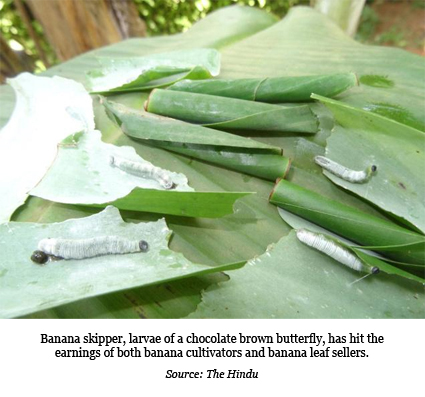by Ganesh Prabhu and Mohit M. Rao
 Banana plantations in many places in the district have been affected by the pest ‘Erionota torus’, also known as Banana Red-Eyed Skipper, Banana Leaf Roller or Banana Skipper, leaving farmers in distress.
Banana plantations in many places in the district have been affected by the pest ‘Erionota torus’, also known as Banana Red-Eyed Skipper, Banana Leaf Roller or Banana Skipper, leaving farmers in distress.
The pest is a chocolate-brown butterfly belonging to the family Hesperiidae. Its larvae cut the leaves at the edges and make a series of cylindrical rolls before developing into pupae. It can damage whole banana leaves leaving only the midribs.
Earnings hit
Banana is grown in about 1,065 hectares in Udupi district according to the Department of Horticulture. The pest is affecting both the farmers who sell bananas and those selling banana leaves.
Upendra Nayak, a farmer who has been cultivating bananas in 1.5 acres of land at Ajekar village in Karkala taluk for the last 30 years, said all the 1,000 banana plants in his field had been affected by banana skipper.
He used to earn about Rs. 2.5 lakh by selling bananas and Rs. 60,000 by selling plantain leaves.
“We are seeing this pest for the first time in the region. I tried everything to control it and failed. I have lost all my earnings from my banana plantation. The government should give compensation to the affected banana farmers,” he said.
Another farmer Srikanth Shenoy from Shirva village said that of the 1,500 plants in his field, nearly 200 were affected by the banana skipper. “I used neem oil mixture to control it. But the pest is spreading rapidly in small banana plantations. More awareness needs to be created about the pest to check its spread,” he said.
A team of agricultural scientists also surveyed the spread of the pest in the district. S.U. Patil, Associate Professor (Entomology) at the Zonal Agricultural and Horticultural Research Station (ZAHRS) in Brahmavar, said the pest had made its presence felt in all three taluks of the district, especially Karkala and Kundapur.
“We have noticed the pest in parts of Padubidri, Hebri, Ajekar, Hirgana, Kundapur, Byndoor, and Brahmavar. We have been receiving calls from farmers informing us of the damage done by the pest and also seeking measures to control it,” he said.
Biological control
Agricultural scientists suggest biological control methods to check the spread of the pest. “It would be better if the farmers install twigs or poles near the banana plantations so that crows and other birds can come and eat the larvae of the banana skipper. This is most effective and safe method to check its spread,” said. Prof. Patil. Guruprasad, Assistant Horticulture Officer, said that if there was more infestation of the pest, farmers could mix four to five millilitres of neem oil in a litre of water and spray it on the leaves.
“It is better if farmers follow biological control methods instead of spraying chemicals to check the pest. Before using any chemicals, it is very essential that the farmers consult agricultural scientists,” Prof. Patil said.
In Dakshina Kannada
Yogesh H.R., Deputy Director of Horticulture, Dakshina Kannada, told The Hindu that banana skipper has been found in small quantity in almost all plantations.
He said banana was being cultivated as an inter-crop in arecanut plantations in the district. It was a short-term crop. Hence it was difficult to get area under its cultivation.
He said the department promoted naendra banana (plantain) cultivation only in 2011-12 as an inter-crop under cluster development programme.
Source: The Hindu
